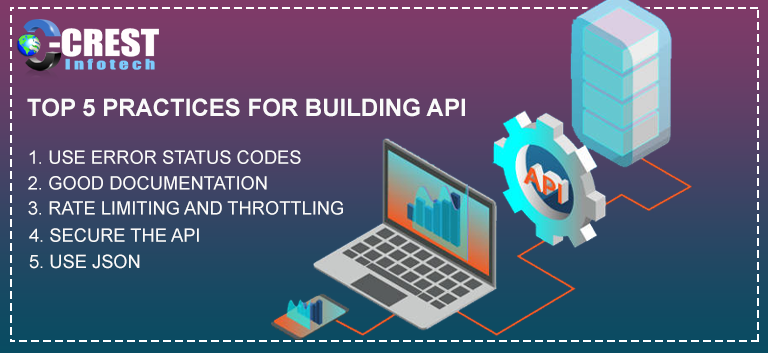Let’ have a look at the top 5 practices for perfect API development.
Throttling
App throttling is the best technique to remember when it comes to redirecting overflow traffic, protecting against DoS (Denial of Service), and backing up APIs.Enable overriding HTTP methodApp throttling is the best technique to remember when it comes to redirecting overflow traffic, protecting against DoS (Denial of Service), and backing up APIs.
SDK and Libraries
Provide critical tools to the development team in order to accelerate the development and deployment of services. This can be accomplished by providing tools that contain reusable processes and code.
Security
You must ensure that your API is safe without sacrificing usability. If a user takes longer than 5 minutes to authenticate, your API is not user-friendly. Token-based authentication can be used to encrypt your API.
Documentation
Another excellent approach to consider is including a diverse collection of documents. You must build comprehensive API documentation that allows other mobile app developers to fully comprehend the entire process so that they can use that knowledge to have a superior user experience.In a nutshell, well-written API documentation lowers project costs, reduces development time, and improves API performance.
Must-have features in API design
Before you begin creating APIs, there are a few things to consider. These points will serve as a catalyst for your API growth and will keep your team on the same page. Let’s take a look at each of these points individually.
Authorization and Authentication
To put it another way, authentication is the process of confirming that you are who you say you are. Authorization, on the other hand, refers to determining whether a verified consumer is authorised to conduct a specific action on a specific source.
For example, although John (an authenticated user) may obtain a resource, he is not permitted to build one.Some of the most widely used standards for handling authorization and authentication are OAuth, OAuth2, and JWT.
Pagination
It’s self-evident that the database will expand over time. When this happens, you’ll notice that some of the resources are taking longer to retrieve than normal. The most popular solution to this problem is to cache the objects or create pagination.Paging is the method of determining how much data should be shown and how often it should be displayed.
Sorting also ensures that the data is delivered to the user in accordance with the specifications, conditions, and modifications.These factors aid in reducing processing time, maintaining high protection, and ensuring a quick response time.
Cache
You can retrieve resources at breakneck speed by implementing a Cache strategy. It will reduce the cost of your requests until the data is ready for consumption in an in-memory database. Cache strategies can be built with tools like Redis and Memcached.
Wrappers
API wrappers are language-specific containers or packets. They make user-friendly functions out of a variety of API calls. The wrapper also allows a number of API calls without having to communicate with the user.
HATEOAS
One of the REST application architecture’s modules is HATEOAS (Hypermedia as the Engine of Application State). Hypermedia refers to any material that contains a connection to other types of media such as text, photographs, videos, and so on.HATEOS allows clients to communicate with REST APIs using dynamically generated responses from the server.
Error handling
Error management that is effective will make debugging simpler by determining if the problem was caused by a server or client error. The client may modify the request for certain mistakes, but for others, they will need to contact help. The following are some useful error-handling techniques:
- Use error codes that are well-known.
- Providing the appropriate number of errors
- Identifying the source of the problem
- Distinguishing between domain and general errors.



